Latest recommendations
| Id | Title * | Authors * | Abstract * | Picture * | Thematic fields * | Recommender | Reviewers | Submission date | |
|---|---|---|---|---|---|---|---|---|---|
10 Aug 2022
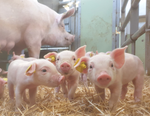
Decreasing the level of hemicelluloses in sow's lactation diet affects the milk composition and post-weaning performance of low birthweight piglets.Francesco Palumbo, Giuseppe Bee, Paolo Trevisi, Marion Girard https://doi.org/10.31220/agriRxiv.2022.00116Varying the hemicellulose content in the diet of lactating sows highlights the importance of early-life interventions for improving health and performance of small piglets during the post-weaning periodRecommended by Florence Gondret based on reviews by Hélène Quesnel and Myriam GrundyOne of the key questions in pig industry nowadays is how health and performance of piglets can be improved by sow nutrition and milk composition. The levels of dietary fibers in sow’s gestation diet have positive effects observed on the litters. However, the composition of dietary fibers and the organization of polysaccharides within the cell wall in the different plants determine their physicochemical properties and, thereby, their behaviour in the gut of the sows and the subsequent physiological response of the animals. Hemicelluloses are polysaccharides constituents of the cell walls of plants, which are fermented in the gut to produce volatile fatty acids (VFA). These VFA can serve as energy source for milk synthesis and can thereby influence the development of suckling piglets. Palumbo and colleagues (1) proposed an original experimental design to compare diets with similar fiber contents but different hemicellulose levels, thanks to varying the sources of fibers used in the dietary formulations. Effects were studied on performance and health of lactating sows and their piglets during suckling period and until post-weaning. The dietary treatments had no effect on the total number of piglets weaned and, consequently, on litter weight at weaning. Milk yield was not influenced by the dietary treatments, but milk composition (lactose content, copper and threonine proportions) was affected by the level of hemicellulose in the maternal diets. With a decreasing hemicellulose level in sow diet, milk lactose content linearly decreased, whereas the copper and threonine contents linearly increased. There was no effect on piglet performance during the lactation period. During the second week of post-weaning, a quadratic increase in the incidence of diarrhoea and the number of days with diarrhoea for suckling piglets was observed with decreasing hemicellulose level in diet. Interestingly, the observed effects were partly different for piglets born with a low body weight. Indeed, there was a linear decrease in the incidence of diarrhoea and days with diarrhoea with decreased hemicellulose level in the maternal diet for those piglets, together with increased growth performance from birth to two weeks post-weaning. The authors postulated that the improved growth performance and the lower incidence of diarrhoea observed in small piglets during post-weaning period may be related to the increased abundance of threonine and copper and increased concentration of total VFA in milk of sows fed a diet with reduced hemicellulose levels. This study confirms the importance of early-life interventions to improve the post-weaning development and health of this sub-population of piglets. Reference (1) Palumbo F, Bee G, Trevisi P, and Girard M. (2022). Decreasing the level of hemicelluloses in sow's lactation diet affects the milk composition and post-weaning performance of low birthweight piglets. agriRxiv 2022.00116, ver 4 (R3), peer-reviewed and recommended by PCI Animal Science. https://doi.org/10.31220/agriRxiv.2022.00116 | Decreasing the level of hemicelluloses in sow's lactation diet affects the milk composition and post-weaning performance of low birthweight piglets. | Francesco Palumbo, Giuseppe Bee, Paolo Trevisi, Marion Girard | <p>Hemicelluloses (HC) are polysaccharides constituents of the cell walls of plants. They are fermented in the gut to produce volatile fatty acids (VFA). The present study investigated the effects of decreasing HC level in sow's lactation diet on ... |  | Pig nutrition | Florence Gondret | 2022-01-21 12:00:22 | View | |
05 Jul 2022

Impact of pre-breeding feeding practices on rabbit mammary gland development at mid-pregnancy.Cathy Hue-Beauvais, Karine Bebin, Raphael Robert, Delphine Gardan-Salmon, Mickael Maupin, Nicolas Brun, Etienne Aujean, Florence Jaffrezic, Steve Simon, Madia Charlier, Fabienne Le Provost https://doi.org/10.1101/2022.01.17.476562Managing the feeding of rabbits to improve metabolic efficiencyRecommended by Giuseppe Conte based on reviews by Marion Boutinaud, Davi Savietto and 1 anonymous reviewerA correct execution of feeding plan for growing rabbit decreases the possibility of post-weaning digestive disorders, thus enhancing the feed efficiency in the animals. However, a limitation of feed daily quantity is required between 10 weeks of age and the first artificial insemination. This limitation causes energy deficiency with a consequent reduction in fertility. Beauvais et al. (2022) studied the impact of feed restriction strategies in female rabbits. Four feed restriction strategies were applied in two distinct periods (post-weaning and puberty) and evaluated by different physiological parameters (growth rate, metabolic profiles, reproductive parameters and mammary gland development). In the first part of the paper, the authors evaluated the association between weight slopes and feeding strategies in the late post-weaning and peripartum period in the four groups. As revealed by the authors, a significant difference was observed during the late post-weaning period, which remained significant between the pubertal and fattening phases. Probably these differences are related to the restriction feeding pattern. The results indicated that restrictive feeding changes in the first step of post-weaning period is associated with a significant difference in body weight. This difference occurs from the third week of diet, highlighting the high sensitivity of growing rabbit to nutrition during the post-weaning period. In the second part of the paper, the authors evaluated the expression of genes involved in the lipid metabolism. During the mid-pregnancy, was revealed a significant higher expression of lipogenic genes, which may be considered as useful markers for the mammary epithelial development in less restrictive strategies during early life period. The results proposed by Beauvais et al. (2022) enlighten the important role played by the feeding conditions of young female rabbits in the early life rearing. In particular, this activity provides specific recommendations for optimizing lactation and thus preventing neonatal mortality of the offspring. Moreover, the authors provide indications about the effect of feeding strategies on the mammary development and gene expression with absolute consequences on the development of offspring. Mammary lipid metabolism affects the milk profile and therefore the growth performance of the young animals. Reference
Hue-Beauvais C, Bebin K, Robert R, Gardan-Salmon D, Maupin M, Brun N, Aujean E, Jaffrezic F, Simon S, Charlier M, Le Provost F (2022). Impact of pre-breeding feeding practices on rabbit mammary gland development at mid-pregnancy. biorXiv, 2022.01.17.476562, ver. 3 peer-reviewed and recommended by Peer Community in Animal Science. https://doi.org/10.1101/2022.01.17.476562 | Impact of pre-breeding feeding practices on rabbit mammary gland development at mid-pregnancy. | Cathy Hue-Beauvais, Karine Bebin, Raphael Robert, Delphine Gardan-Salmon, Mickael Maupin, Nicolas Brun, Etienne Aujean, Florence Jaffrezic, Steve Simon, Madia Charlier, Fabienne Le Provost | <p>Optimizing rabbit does preparation during early life to improve reproductive potential is a major challenge for breeders. Does selected for reproduction have specific nutritional needs, which may not be supplied with the common practice of feed... |  | Animal nutrition modelling | Giuseppe Conte | 2022-01-19 14:44:30 | View | |
24 May 2022
Identifying cattle with superior growth feed efficiency through their natural 15N abundance and plasma urea concentration: a meta-analysis.Gonzalo Cantalapiedra-Hijar, Isabelle Morel, Bernard Sepchat, Céline Chantelauze, Gemma A. Miller, Carol-Anne Duthie, Isabelle Ortigues-Marty, Richard J. Dewhurst https://doi.org/10.5281/zenodo.578396015N as a marker for feed efficiency in beef cattleRecommended by Marcos Marcondes based on reviews by Emilio Mauricio Ungerfeld and 1 anonymous reviewerIdentifying individuals with a more remarkable feed efficiency may positively affect the profitability and sustainability of the beef industry (Cruz et al., 2010; Basarab et al., 2013). However, although most international nutrient requirements systems predict animal feed efficiency, intake data is usually unavailable at the farm level, and ranking animals based on efficiency might be challenging. In this sense, using differences in the occurrence of isotopic N between animal and diet (Δ15Nanimal-diet) might become a natural biomarker to determine feed efficiency at the farm level. This methodology was firstly demonstrated by Guarnido-Lopez et al. (2021). In the present study by Cantalapiedra-Hijar et al. (2022), the authors evaluated the extent to which Δ15Nanimal-diet can be used as a marker for feed efficiency in beef animals. For this, a meta-analysis was conducted using a database including 759 individual records for performance and N isotopic discrimination measured in plasma or muscle (Δ15Nanimal-diet; n = 749) and plasma urea concentration (n = 659). The database was composed of 37% Charolais, 15% Simmental, and 40% of beef crossbreds. The results confirmed that Δ15Nanimal-diet could discriminate animals with at least 0.10 kg/kg difference in feed efficiency. Furthermore, the Δ15Nanimal-diet marker also successfully discriminated the feed efficiency of two animals from the same contemporary group if they differ by at least 0.06 kg/kg of FCE. However, when trying to predict feed efficiency, using the two candidate biomarkers did not improve estimates. Lastly, when data from biomarkers were combined with performance data, improvement in the predictions was observed. Nonetheless, the present results warrant more studies to evaluate the use of Δ15Nanimal-diet as a biomarker for feed efficiency since it could be used not only for feed efficiency discrimination but also in genetic selections.
References Cantalapiedra-Hijar G, Morel I, Sepchat B, Chantelauze C, Miller GA, Duthie CA, Ortigues-Marty I, Dewhurst RJ (2022). Identifying cattle with superior growth feed efficiency through their natural 15N abundance and plasma urea concentration: A meta-analysis. Zenodo, 5783960, ver. 3 peer-reviewed and recommended by Peer community in Animal Science. https://doi.org/10.5281/zenodo.5783960. Cruz GD, Rodríguez-Sánchez JA, Oltjen JW, Sainz RD (2010). Performance, residual feed intake, digestibility, carcass traits, and profitability of Angus-Hereford steers housed in individual or group pens. J. Anim. Sci. 88:324-329. https://doi.org/10.2527/jas.2009-1932. Basarab JA, Beauchemin KA, Baron VS, Ominski KH, Guan LL, Miller SP, Crowley JJ (2013). Reducing GHG emissions through genetic improvement for feed efficiency: effects on economically important traits and enteric methane production. Animal 7:303-315. https://doi.org/10.1017/S1751731113000888. Guarnido-Lopez P, Ortigues-Marty I, Taussat S, Fossaert C, Renand G, Cantalapiedra-Hijar G (2021). Plasma proteins Δ15N vs. plasma urea as candidate biomarkers of between-animal variations of feed efficiency in beef cattle: Phenotypic and genetic evaluation. Animal 15:100318. https://doi.org/10.1016/j.animal.2021.100318.
| Identifying cattle with superior growth feed efficiency through their natural 15N abundance and plasma urea concentration: a meta-analysis. | Gonzalo Cantalapiedra-Hijar, Isabelle Morel, Bernard Sepchat, Céline Chantelauze, Gemma A. Miller, Carol-Anne Duthie, Isabelle Ortigues-Marty, Richard J. Dewhurst | <p>The objective of this study was to test two candidate biomarkers of feed efficiency in growing cattle. A database was built using performance data from 13 trials conducted with growing heifers, steers and young bulls and testing 34 dietary trea... | Physiology, Ruminant nutrition | Marcos Marcondes | 2021-12-07 15:24:15 | View | ||
09 Apr 2022
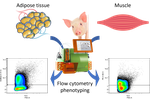
The impact of housing conditions on porcine mesenchymal stromal/stem cell populations differ between adipose tissue and skeletal muscleAudrey Quéméner, Frédéric Dessauge, Marie-Hélène Perruchot, Nathalie Le Floc’h, Isabelle Louveau https://doi.org/10.1101/2021.06.08.447546Housing conditions affect cell populations in adipose and muscle tissues of pigsRecommended by Hervé Acloque based on reviews by 2 anonymous reviewersThe adaptability of livestock to changing environments is based in particular on their genetic characteristics but also on the farming conditions to which they are subjected. However, this last point is poorly documented and little is known about its contribution to environmental challenges. The study by Quéméner and colleagues [1] addresses this question by assessing the effect of two hygiene conditions (good vs poor) on the distribution of cell populations present in adipose and muscle tissues of pigs divergently selected for feed efficiency [2]. The working hypothesis is that degraded housing conditions would be at the origin of an hyper stimulation of the immune system that can influence the homeostasis of adipose tissue and skeletal muscle and consequently modulate the cellular content of these tissues. Cellular compositions are thus interesting intermediate phenotypes for quantifying complex traits. The study uses pigs divergently selected for residual feed intake (RFI+ and RFI-) to assess whether there is a genetic effect associated with the observed phenotypes. The study characterized different stromal cell populations based on the expression of surface markers: CD45 to separate hematopoietic lineages and markers associated with the stem properties of mesenchymal cells: CD56, CD34, CD38 and CD140a. The authors observed that certain subpopulations are differentially enriched according to the hygiene condition (good vs poor) in adipose and skeletal tissue (CD45-CD56-) sometimes with an associated (genetic) lineage effect. This pioneering study validates a number of tools for characterizing cell subpopulations present in porcine adipose and muscle tissue. It confirms that housing conditions can have an effect on intermediate phenotypes such as intra-tissue cell populations. This pioneering work will pave the way to better understand the effects of livestock systems on tissue biology and animal phenotypes and to characterize the nature and function of progenitor cells present in muscle and adipose tissue. [1] Quéméner A, Dessauge F, Perruchot MH, Le Floc’h N, Louveau I. 2022. The impact of housing conditions on porcine mesenchymal stromal/stem cell populations differ between adipose tissue and skeletal muscle. bioRxiv 2021.06.08.447546, ver. 3 peer-reviewed and recommended by Peer Community in Animal Science. https://doi.org/10.1101/2021.06.08.447546 [2] Gilbert H, Bidanel J-P, Gruand J, Caritez J-C, Billon Y, Guillouet P, Lagant H, Noblet J, Sellier P. 2007. Genetic parameters for residual feed intake in growing pigs, with emphasis on genetic relationships with carcass and meat quality traits. Journal of Animal Science 85:3182–3188. https://doi.org/10.2527/jas.2006-590. | The impact of housing conditions on porcine mesenchymal stromal/stem cell populations differ between adipose tissue and skeletal muscle | Audrey Quéméner, Frédéric Dessauge, Marie-Hélène Perruchot, Nathalie Le Floc’h, Isabelle Louveau | <p><strong>Background.</strong> In pigs, the ratio between lean mass and fat mass in the carcass determines production efficiency and is strongly influenced by the number and size of cells in tissues. During growth, the increase in the number of c... |  | Monogastrics, Physiology, Veterinary science | Hervé Acloque | 2021-06-08 17:34:54 | View | |
07 Feb 2022
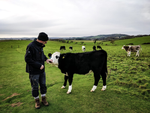
Resilience: reference measures based on longer-term consequences are needed to unlock the potential of precision livestock farming technologies for quantifying this traitFriggens, N. C., Adriaens, I., Boré, R., Cozzi, G., Jurquet, J., Kamphuis, C., Leiber, F., Lora, I., Sakowski, T., Statham, J. and De Haas, Y. https://doi.org/10.5281/zenodo.5215797Measuring resilience in farm animals: theoretical considerations and application to dairy cowsRecommended by Aurélien Madouasse based on reviews by Ian Colditz and 2 anonymous reviewers based on reviews by Ian Colditz and 2 anonymous reviewers
Farm animals differ in their ability to respond to the many environmental challenges they face. Such challenges include infectious diseases, metabolic diseases resulting from inadequate coverage of dietary needs, as well as the diverse consequences of climate change. Various concepts exist to characterise the responses of animals to different types of challenges. This article by Friggens et al. (2022) focuses on resilience, providing a conceptual definition and proposing a method to quantify resilience in dairy cows. The first part of the paper provides a definition of resilience and highlights its differences and relations with the related concepts of robustness, and, to a lesser extent, resistance and tolerance. In essence, resilience is the ability of an animal to bounce back quickly after a challenge of limited duration. On the other hand, robustness is the ability of an animal to cope with conditions that are overall unfavourable. From these conceptual and intuitive definitions, there are several difficulties precluding the design of concrete methods to measure resilience. First, there is some degree of overlap between the concepts of resilience, robustness, resistance and tolerance. Secondly, resilience is a multidimensional concept whereby resilience to a given perturbation does not imply resilience to other types of perturbation, e.g. resilience to a challenge by a specific pathogen does not imply resilience to a nutritional challenge. A further difficulty in the measure of resilience is the fact that different animals may be exposed to challenges that are different in nature and in number. The authors argue that although resilience cannot be measured directly (it should be seen as a latent construct), it is possible to quantify it indirectly through its consequences. In the second part of the paper, the authors propose a method to quantify resilience of individual dairy cows. The method is based on the premise that resilient animals should be kept longer in their herd than non-resilient animals. The main criterion in the evaluation is therefore the ability of cows to re-calve. Each cow that is calving receives a certain number of points, to which, in each lactation, bonus points are added for higher milk production and penalty points are removed for each insemination after the first one, for each disease event and for each day of calving interval above some herd specific value. Therefore, cows have a resilience score in each lactation. They also have a lifetime resilience score obtained by summing the scores for all the lactations, that gets bigger as the cow has more calves, and that also takes the age at first calving into account. In a previous study, Adriaens et al. (2020) showed that higher resilience scores were associated with fewer drops in milk yield and more stable activity dynamics. Starting from theoretical considerations on the notion of resilience, this paper describes a concrete method to quantify animal-level resilience on farm. Such quantification will be useful for breeding and culling decisions. Finally, the general framework to design resilience measures that is presented will be useful to researchers working on the quantification of farm animal resilience using new methods and data sources.
References Adriaens I, Friggens NC, Ouweltjes W, Scott H, Aernouts B and Statham J 2020. Productive life span and resilience rank can be predicted from on-farm first-parity sensor time series but not using a common equation, across farms. Journal of Dairy Science 103, 7155-7171.https://doi.org/10.3168/jds.2019-17826 Friggens, N.C. , Adriaens, I., Boré, R., Cozzi, G., Jurquet, J., Kamphuis, C., Leiber, F., Lora, I., Sakowski, T., Statham, J., De Haas, Y. (2022). Resilience: reference measures based on longer-term consequences are needed to unlock the potential of precision livestock farming technologies for quantifying this trait. Zenodo, 5215797, ver. 5 peer-reviewed and recommended by Peer community in Animal Science. https://dx.doi.org/10.5281/zenodo.5215797 | Resilience: reference measures based on longer-term consequences are needed to unlock the potential of precision livestock farming technologies for quantifying this trait | Friggens, N. C., Adriaens, I., Boré, R., Cozzi, G., Jurquet, J., Kamphuis, C., Leiber, F., Lora, I., Sakowski, T., Statham, J. and De Haas, Y. | <p style="text-align: justify;">Climate change, with its increasing frequency of environmental disturbances puts pressures on the livestock sector. To deal with these pressures, more complex traits such as resilience must be considered in our mana... |  | Precision livestock farming | Aurélien Madouasse | 2021-08-20 15:34:13 | View | |
28 Jan 2022
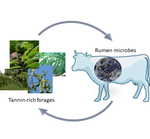
Microbial colonization of tannin-rich tropical plants: interplay between degradability, methane production and tannin disappearance in the rumenMoufida Rira, Diego P Morgavi, Milka Popova, Gaelle Maxin, Michel Doreau https://doi.org/10.1101/2021.08.12.456105Ruminal microbial degradation of tannin-rich tropical plants and methane productionRecommended by Antonio Faciola based on reviews by Todd Callaway and Srinivasan MahalingamRira et al. (2022) evaluated ruminal degradation of tropical tannins-rich plants and the relationship between condensed tannins disappearance and microbial communities. I found this study relevant because a major limitation for tropical plants utilization by ruminants is their potential reduced nutrient digestion. In this study, authors used leaves from Calliandra calothyrsus, Gliricidia sepium, and Leucaena leucocephala, pods from Acacia nilotica and the leaves of Manihot esculenta and Musa spp., which were incubated in situ in the rumen of dairy cows. An in vitro approach was also used to assess the effects of these plants on ruminal fermentation. They observed that hydrolysable and free condensed tannins from all plants completely disappeared after 24 h incubation in the rumen. Disappearance of protein-bound condensed tannins was variable with values ranging from 93% for Gliricidia sepium to 21% for Acacia nilolitica. This demonstrated some potential for selection and improvements in protein digestion. In contrast, fibre-bound condensed tannins disappearance averaged ~82% and did not vary between plants, which was remarkable. The authors noted that disappearance of bound fractions of condensed tannins was not associated with degradability of plant fractions and that the presence of tannins interfered with the microbial colonisation of plants. Each plant had distinct bacterial and archaeal communities after 3 and 12 h of incubation in the rumen and distinct protozoal communities at 3 h. This suggests a great deal of specificity for microbial-plant interactions, which warrants further evaluation to consider also animal contributions to such specificity. Adherent communities in tannin-rich plants had a lower relative abundance of fibrolytic microbes, notably Fibrobacter spp. Whereas, archaea diversity was reduced in high tannin-containing Calliandra calothyrsus and Acacia nilotica at 12 h of incubation. Concurrently, in vitro methane production was lower for Calliandra calothyrsus, Acacia nilotica and Leucaena leucocephala although for the latter total volatile fatty acids production was not affected and was similar to control. Finally, the study demonstrated that the total amount of hydrolysable and condensed tannins contained in a plant play a role governing the interaction with rumen microbes affecting degradability and fermentation. The effect of protein- and fibre-bound condensed tannins on degradability is less important. The major limitation of the study is the lack of animal validation at this stage; therefore, further studies are warranted, especially studies evaluating these plants in vivo. Furthermore, mechanisms associated with plant-microbial specificity, the role played by the host, and more data on nutrient utilization and gas production should be investigated. Nonetheless, this work show interesting microbial colonization and specific plant-microbial relationships that are novel in the ruminal environment. Reference: Rira M, Morgavi DP, Popova M, Maxin G, Doreau M (2022). Microbial colonization of tannin-rich tropical plants: interplay between degradability, methane production and tannin disappearance in the rumen. bioRxiv, 2021.08.12.456105, ver. 3 peer-reviewed and recommended by Peer Community in Animal Science. https://doi.org/10.1101/2021.08.12.456105
| Microbial colonization of tannin-rich tropical plants: interplay between degradability, methane production and tannin disappearance in the rumen | Moufida Rira, Diego P Morgavi, Milka Popova, Gaelle Maxin, Michel Doreau | <p>Condensed tannins in plants are found free and attached to protein and fibre but it is not<br>known whether these fractions influence rumen degradation and microbial colonization.<br>This study explored the rumen degradation of tropical tannins... |  | Animal nutrition modelling, Cattle production, Emissions , Farming systems, Gut microbiology, Microbial ecology, Microbial fermentation, Rumen microbiology, Rumen microbiome , Ruminant nutrition | Antonio Faciola | 2021-08-16 08:56:45 | View | |
20 Dec 2021
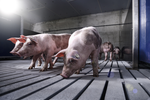
Quantifying growth perturbations over the fattening period in swine via mathematical modellingManuel Revilla, Guillaume Lenoir, Loïc Flatres-Grall, Rafael Muñoz-Tamayo, Nicolas C Friggens https://doi.org/10.1101/2020.10.22.349985An innovative modelling approach to enhance the quality of the quantification of pig resilience during the entire fattening period: Towards an individual pig resilience indexRecommended by Mohammed Gagaoua based on reviews by Arata Hidano, Ludovic Brossard and 2 anonymous reviewers based on reviews by Arata Hidano, Ludovic Brossard and 2 anonymous reviewers
The identification of reliable estimates of growth potential and resilience over the fattening period in large populations is a challenge in actual swine breeding conditions. To overcome this drawback, the study by Revilla et al. 2021 in the frame of precision livestock farming aimed to propose an innovative modelling approach, in addition to previous studies from the same group (Revilla et al. 2019), to enhance the quality of the quantification of pig resilience during the entire fattening period. The authors developed a model that quantifies an “individual pig resilience indicator” based on longitudinal data, for instance body weight, recorded routinely by a commercially available automatic feeding system. Revilla and co-workers considered in their study two mainly commercialised pure pig breeds these being Piétrain including Piétrain Français NN Axiom line (Pie NN) free from halothane-sensitivity (ryanodine receptor gene, RYR1) and Piétrain Français Axiom line positive to this gene and Duroc. Therefore, the authors investigated the potential of improving resilience of swine livestock through inclusion for the first time of an “individual pig resilience indicator” in breeding objectives. A database of 13 093 boars (approximately 11.1 million of weightings) belonging to Pie (n= 5 841), Pie NN (n = 5 032) and Duroc (n= 2 220) finished under ad libitum feeding, high sanitary level and controlled temperature was used to develop robust models. The authors checked the three datasets (for each pig breed) independently to explore the variation and gaps (a data pre-treatment procedure) to ensure high quality data for the modelling approach. Then, they applied the Gompertz model and linear interpolation on body weight data to quantify individual deviations from the expected production, allowing the creation of the ABC index. For the modelling, the authors applied a two-step mathematical model approach by first establishing a theoretical growth curve of each animal, while the second step aimed to build the actual perturbed growth curve. The heritability of the index ranged from 0.03 to 0.04, with similar heritability between Piétrain and Duroc breeds. Moreover, moderate genetic relationships were computed between the proposed index and important phenotypic traits in swine production likely BF100: backfat thickness at 100kg; LD100: longissimus dorsi thickness at 100kg; ADG: average daily gain during control and FCR: feed conversion ratio. Developing models able to capture perturbations during the fattening period is a challenge in swine breeding industry. The model and methodology proposed by the authors in this innovative work (although preliminary and with low heritabilities) would help overcome such limit and facilitate a real implementation at large scale in pig breeding system. The modelling approach further offers an opportunity to develop a selection criterion to improve resilience in swine breeding conditions. To explore the full potential of this modelling approach, a larger database and other factors such as breed, behaviour and feeding behaviour of the animals, rearing practices, management and environment conditions, age… etc. are worthy to consider. In the future, more in depth measurements of behaviour that can be computed for example using computer vision should be desirable to increase the robustness of the proposed model. References Revilla, M., Friggens, N.C., Broudiscou, L.P., Lemonnier, G., Blanc, F., Ravon, L., Mercat, M.J., Billon, Y., Rogel-Gaillard, C., Le Floch, N. and Estellé, J. (2019). Towards the quantitative characterisation of piglets’ robustness to weaning: a modelling approach. Animal, 13(11), 2536-2546. https://doi.org/10.1017/S1751731119000843 Revilla M, Lenoir G, Flatres-Grall L, Muñoz-Tamayo R, Friggens NC (2021). Quantifying growth perturbations over the fattening period in swine via mathematical modelling. bioRxiv, 2020.10.22.349985, ver. 5 peer-reviewed and recommended by Peer Community in Animal Science. https://doi.org/10.1101/2020.10.22.349985 | Quantifying growth perturbations over the fattening period in swine via mathematical modelling | Manuel Revilla, Guillaume Lenoir, Loïc Flatres-Grall, Rafael Muñoz-Tamayo, Nicolas C Friggens | <p>Background: Resilience can be defined as the capacity of animals to cope with short-term perturbations in their environment and return rapidly to their pre-challenge status. In a perspective of precision livestock farming, it is key to create i... |  | Animal genetics, Animal health, Farming systems, Mathematical modelling, Precision livestock farming | Mohammed Gagaoua | 2020-10-26 11:47:08 | View | |
02 Sep 2021

A modelling framework for the prediction of the herd-level probability of infection from longitudinal dataAurélien Madouasse, Mathilde Mercat, Annika van Roon, David Graham, Maria Guelbenzu, Inge Santman Berends, Gerdien van Schaik, Mirjam Nielen, Jenny Frössling, Estelle Ågren, Roger Humphry, Jude Eze, George Gunn, Madeleine Henry, Jörn Gethmann, Simon J. More, Nils Toft, Christine Fourichon https://doi.org/10.1101/2020.07.10.197426Modelling freedom from disease - how do we compare between countries?Recommended by Rowland Raymond Kao based on reviews by Arata Hidano and 1 anonymous reviewerIn this paper, Madouasse et al. (2021) present a generalisable Bayesian method for calculating the probability that a herd is free from disease, based on its prior disease status, and using data (herd status over time over a sufficient number of herds to inform the model) and reasonable prior estimates of the sensitivity and specificity of tests being used to determine animal infection status. Where available, the modelling approach can also include relevant additional risk factors. By bringing all these factors together, it allows for most countries to use the same analytical approach on their data, with differences across datasets expressed in terms of the uncertainty around the central estimates. Having a single methodology that generates both a central estimate of disease freedom, and uncertainty thus provides the opportunity (given typically available data) to compare the probability of freedom across different systems. This is relevant in terms of the context of trade (since international trade of livestock in many cases depends on disease freedom). It is also important when evaluating, for example, transnational burdens of disease - and with different regulations in place in different countries, this is invaluable and can be used, for example, to assess risks of zoonotic infection including for zoonotic infection emergence. In the BVD example provided, the point is made that, since regular testing would probably pick up infection rapidly, the addition of risk factors is most valuable where testing is infrequent. This emphasizes the advantages of direct incorporation of risk factors into a single modelling framework. From a technical point of view, the analysis compares two different packages for the Markov Chain Monte Carlo (MCMC) implementation necesary to run the model. They show that, while there are some slight systematic differences, the estimates provided by the two methods are similar to each other; as one method is approximate but substantially more stable and generally much more computationally efficient, this is an important outcome. Both implementations are freely available and with relevant additional software made similarly available by the authors. This is extremely welcome and should encourage its general adoption across different countries. No single model can of course account for everything. In particular, the reliance on past data means that there is an implicit assumption common to all purely statistical methods that the underlying risks have not changed. Thus projections to altered circumstances (changing underlying risk factors or systematic changes in testing or test performance) cannot so easily be incorporated, since these factors are complicated by the dynamics of infection that lie outside the modelling approach. Of course the well known quote from George Box that "all models are wrong" applies here - the generality of approach, statistical robustness and open source philosophy adopted make this model very useful indeed. Madouasse A, Mercat M, van Roon A, Graham D, Guelbenzu M, Santman Berends I, van Schaik G, Nielen M, Frössling J, Ågren E, Humphry RW, Eze J, Gunn GJ, Henry MK, Gethmann J, More SJ, Toft N, Fourichon C (2021) A modelling framework for the prediction of the herd-level probability of infection from longitudinal data. bioRxiv, 2020.07.10.197426, ver. 6 peer-reviewed and recommended by PCI Animal Science. https://doi.org/10.1101/2020.07.10.197426
| A modelling framework for the prediction of the herd-level probability of infection from longitudinal data | Aurélien Madouasse, Mathilde Mercat, Annika van Roon, David Graham, Maria Guelbenzu, Inge Santman Berends, Gerdien van Schaik, Mirjam Nielen, Jenny Frössling, Estelle Ågren, Roger Humphry, Jude Eze, George Gunn, Madeleine Henry, Jörn Gethmann, Sim... | <p>The collective control programmes (CPs) that exist for many infectious diseases of farm animals rely on the application of diagnostic testing at regular time intervals for the identification of infected animals or herds. The diversity of these ... |  | TEST, Veterinary epidemiology | Rowland Raymond Kao | 2020-07-23 08:13:18 | View | |
16 Apr 2021

Modelling the impact of the macroalgae Asparagopsis taxiformis on rumen microbial fermentation and methane productionRafael Muñoz-Tamayo , Juana C. Chagas, Mohammad Ramin, Sophie J. Krizsan https://doi.org/10.1101/2020.11.09.374330Understanding the mechanisms behind natural bioactive compounds that can potentially reduce methane production in anaerobic conditions. A case study of Asparagopsis taxiformisRecommended by Luis Tedeschi based on reviews by Alberto Atzori, Henk van Lingen and 2 anonymous reviewers based on reviews by Alberto Atzori, Henk van Lingen and 2 anonymous reviewers
Naturally occurring compounds that can reduce methane production in anaerobic conditions have been studied for quite some time as feasible approaches to mitigate methane production in ruminant animals, especially those of commercial importance. Asparagopsis taxiformis (red algae) and Dictyota bartayresii (brown algae) are effective inhibitors of methane synthesis under in vitro anaerobic fermentation systems (Machado et al., 2014) likely because of their high concentration of secondary metabolites that are toxic to the typical rumen microbiota, including protozoa. In addition to phytoplankton (Palmer and Reason, 2009), Asparagopsis contains a high concentration of haloform compounds (e.g., bromoform, chloroform) while Dictyota has a high concentration of isoprenoid terpenes. Despite the economic and biological impact of diverse phytochemicals on reducing methane production in ruminant animals (Tedeschi et al., 2021), haloform compounds’ environmental impact and safety, in particular, are still unclear. In the present study, Munõz-Tamayo and collaborators (2021) listed relevant literature about the impact of A. taxiformis on ruminal methane production. Concurrent to the understanding of mechanisms and biology behind the reduction of ruminal methane, mathematical models can lead the way to enhance the effectiveness of feeding A. taxiformis under commercial applications. Thus, in the present study, Munõz-Tamayo and collaborators (2021) sought to develop a mathematical model to understand the rumen fermentation changes in vitro experimentation containing extract of A. taxiformis by adapting a previously documented model by Muñoz-Tamayo et al. (2016). Modeling development, calibration, and evaluation steps should be independent of each other, requiring complete, distinct, and separate databases (Tedeschi, 2006). However, in rare circumstances where such requirements cannot be met because data availability is scarce, the cross-validation technique, when possible, should be considered to assess data dispersion’s effects on model adequacy. In other situations, clear reasoning for failing to do so must be addressed in the paper. In the present paper, Munõz-Tamayo and collaborators (2021) explained the limitations in their modeling efforts were primarily due to the lack of ideal data: “experiments with simultaneous dynamic data of bromoform, volatile fatty acids, hydrogen, and methane.” Regardless of the availability of ideal data, improvements in the conceptual model are warranted to include amino acids and branched-chain fatty acids fermentation dynamics in the rumen and the fluctuations in ruminal pH. References Machado L, Magnusson M, Paul NA, Nys R de, Tomkins N (2014) Effects of Marine and Freshwater Macroalgae on In Vitro Total Gas and Methane Production. PLOS ONE, 9, e85289. https://doi.org/10.1371/journal.pone.0085289 Muñoz-Tamayo R, Chagas JC, Ramin M, Krizsan SJ (2021) Modelling the impact of the macroalgae Asparagopsis taxiformis on rumen microbial fermentation and methane production. bioRxiv, 2020.11.09.374330, ver. 4 peer-reviewed and recommended by PCI Animal Science. https://doi.org/10.1101/2020.11.09.374330 Muñoz-Tamayo R, Giger-Reverdin S, Sauvant D (2016) Mechanistic modelling of in vitro fermentation and methane production by rumen microbiota. Animal Feed Science and Technology, 220, 1–21. https://doi.org/10.1016/j.anifeedsci.2016.07.005 Palmer CJ, Reason CJ (2009) Relationships of surface bromoform concentrations with mixed layer depth and salinity in the tropical oceans. Global Biogeochemical Cycles, 23. https://doi.org/10.1029/2008GB003338 Tedeschi LO (2006) Assessment of the adequacy of mathematical models. Agricultural Systems, 89, 225–247. https://doi.org/10.1016/j.agsy.2005.11.004 Tedeschi LO, Muir JP, Naumann HD, Norris AB, Ramírez-Restrepo CA, Mertens-Talcott SU (2021) Nutritional Aspects of Ecologically Relevant Phytochemicals in Ruminant Production. Frontiers in Veterinary Science, 8. https://doi.org/10.3389/fvets.2021.628445 | Modelling the impact of the macroalgae Asparagopsis taxiformis on rumen microbial fermentation and methane production | Rafael Muñoz-Tamayo , Juana C. Chagas, Mohammad Ramin, Sophie J. Krizsan | <p>Background: The red macroalgae Asparagopsis taxiformis is a potent natural supplement for reducing methane production from cattle. A. taxiformis contains several anti-methanogenic compounds including bromoform that inhibits directly methanogene... |  | Agricultural sustainability, Animal nutrition modelling, Emissions , Mathematical modelling, Microbial fermentation, Rumen microbiology, Rumen microbiome | Luis Tedeschi | 2020-11-17 06:28:29 | View | |
15 Dec 2020
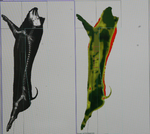
Accuracy of predicting chemical body composition of growing pigs using dual-energy X-ray absorptiometryClaudia Kasper, Patrick Schlegel, Isabel Ruiz-Ascacibar, Peter Stoll, Giuseppe Bee https://doi.org/10.1101/2020.09.15.286153Accurate predictions of chemical composition of pigs for a wide range of body weights: no longer a myth!Recommended by Florence Gondret based on reviews by Mathieu Monziols and 1 anonymous reviewerAssessing body or carcass composition in growing pigs is essential to refine nutritional models, select for specific traits and evaluate pork products. The gold standard methods are dissection and chemical measurements, which are time-consuming and invasive ways to obtain the data. Different teams have tested dual-energy x-ray absorptiometry (DEXA), especially for determining total and regional body composition of fat, soft lean tissues and bone minerals [1-3]. The DEXA measurements are quick, non-invasive, precise, and operator independent. However, the instruments from different manufacturers are unique in implementation so that it is difficult to obtain and share generalized equations. In addition, the validity and accuracy of the measures when applied to pigs having very different composition have been scarcely addressed.
The present manuscript shows that carcass analysis by DEXA can be used to predict empty body chemical composition, and it provides accuracy values for the content in single nutrients (protein, lipids, Ca, P). The body weight range used to generate differences in body composition is very large (20 to 100 kg), which is important when studying pigs along growth. Moreover, regression equations within weight classes (20, 60 and 100 kg) show no important biases, with the exception for body fat especially at the earliest growth stages. Limitations of the technique are the needs of anesthesia when applied to living pigs, and of standardizing the positions of body, carcass and cuts when applied to living or dissected pigs. Another originality of the manuscript is the comparison of the obtained calibrations with previously published prediction models, showing that the differences do not preclude the possibility to use a single model when built from a meta-analysis of the different data. Taken together, this work offers good perspectives to refine nutritional models by inputs from rapidly analyzed body chemical composition and to monitor body and carcass composition in several pigs for genetics applications.
References [1] Mitchell AD., Scholz AM., Pursel VG., and Evock-Clover CM. (1998). Composition analysis of pork carcasses by dual-energy x-ray absorptiometry. Journal of Animal Science. 76(8), 2104-14. https://doi.org/10.2527/1998.7682104x [2] Marcoux M., Bernier JF., and Pomar C. (2003). Estimation of Canadian and European lean yields and composition of pig carcasses by dual-energy X-ray absorptiometry. Meat Science. 63(3), 359-65. https://doi.org/10.1016/S0309-1740(02)00094-3 [3] Kipper M., Marcoux M., Andretta I., and Pomar C. (2018). Repeatability and reproducibility of measurements obtained by dual-energy X-ray absorptiometry on pig carcasses. Journal of Animal Science, 96(5), 2027-2037. https://doi.org/10.1093/jas/skx046 " | Accuracy of predicting chemical body composition of growing pigs using dual-energy X-ray absorptiometry | Claudia Kasper, Patrick Schlegel, Isabel Ruiz-Ascacibar, Peter Stoll, Giuseppe Bee | <p>Studies in animal science assessing nutrient and energy efficiency or determining nutrient requirements necessitate gathering exact measurements of body composition or body nutrient contents. Wet chemical analysis methods or standardized dissec... |  | Agricultural sustainability, Animal nutrition modelling, Monogastrics, Physiology, Pig nutrition | Florence Gondret | 2020-09-17 10:44:58 | View |
FOLLOW US
MANAGING BOARD
Karol B Barragán-Fonseca
Mohammed Gagaoua
Rachel Gervais
Florence Gondret
Francois Meurens
Rafael Muñoz-Tamayo*
Christian Nawroth
Seyed Abbas Rafat
Yuliaxis Ramayo-Caldas
* Representative









